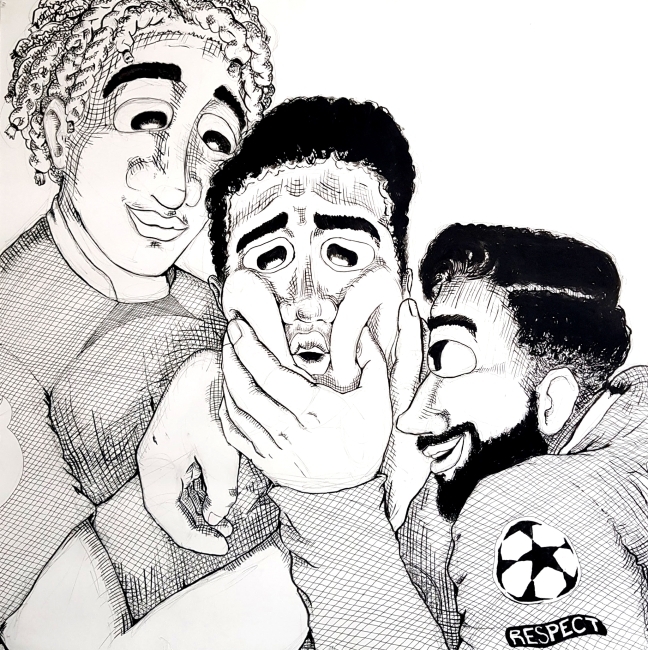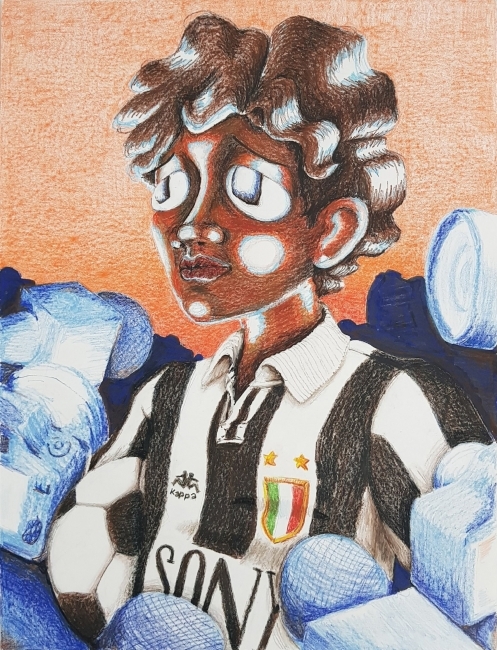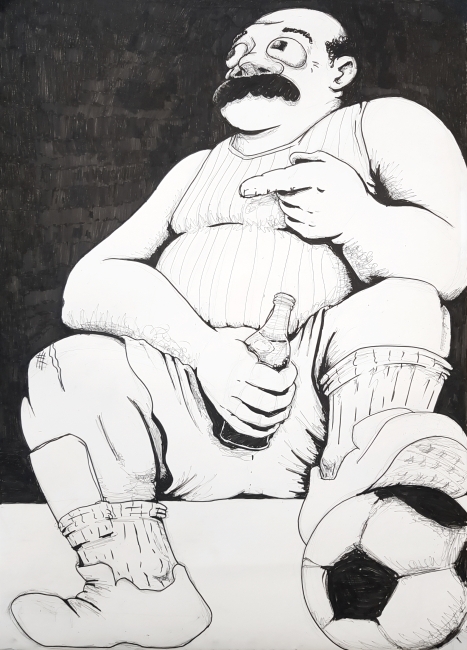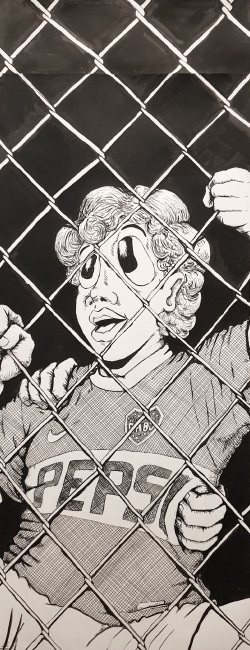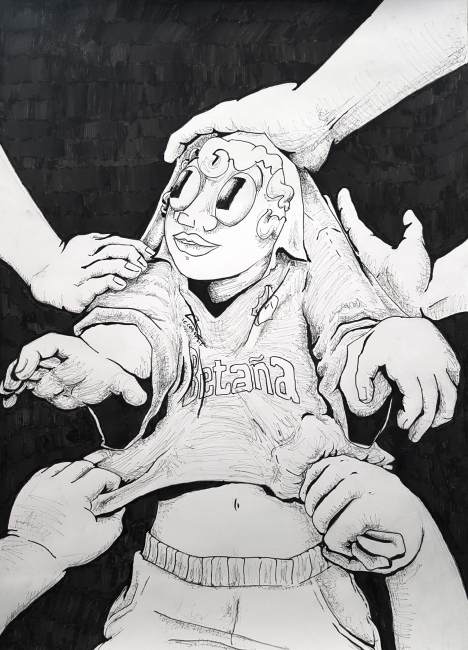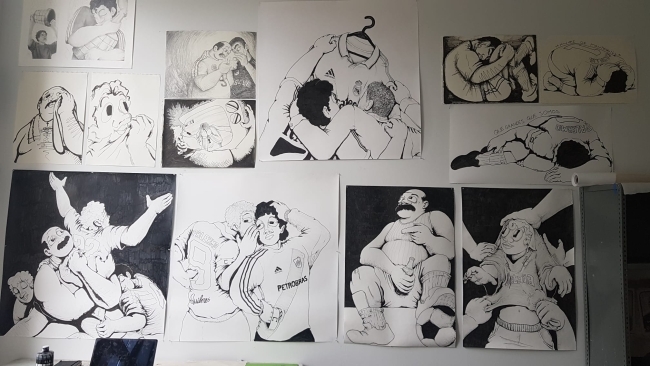Students Gear Up for Verna Case Symposium--a Day to Celebrate Discovery, Scholarship and Creative Inspiration
May 1, 2023
- Author
- Mary Elizabeth DeAngelis

2022 Verna Miller Case Symposium
The bands are warming up, the students are practicing their presentations, and the weather forecast looks good for Davidson College’s annual Verna Miller Case Research and Creative Works Symposium on Wednesday.
The symposium is open to the public and begins at 9 a.m. on the main stage at Richardson Plaza and goes until 4:30 p.m. Visit the symposium website for a full schedule of events.
Hundreds of students present their research, creative works and community-based learning projects at the campus-wide celebration. It’s a great opportunity to see what students have been up to this year, from medical research to defying gravity though physics, to song, dance and theatrical performances. And there’s lunch!
We asked some students to give us a preview of their projects before the event.
Fathers and Babies: The Causal Effect of Paternity Leave Policies on Fertility Rates
What inspired it?
My economics senior session is centered around the economist Gary Becker, who developed models on many topics, including how people decide on the number of kids they might have. My project is an extension on Becker’s ideas; I wanted to explore the extent to which parental leave policies, particularly the father’s ability to take time off work, relate to decisions about the number of children in a family.
What’s your takeaway?
This model is consistent with my hypothesis that paternity leave policies lead to increases in fertility rates in Nordic countries based on the mechanisms that fathers’ involvement post childbirth eases mothers’ burden and aids in child development, decreasing the marginal cost of having a child and making it easier to realize childbearing plans.
A Proposal to Help Close the Achievement Gap in Charlotte-Mecklenburg Schools
What inspired it?
I have always been interested in the opportunity and achievement gaps that exist among different groups of people, particularly concerning schooling and the college admissions process. This inspired me to take a closer look at the root of these issues and how it applies to the Charlotte-Mecklenburg area.
What’s your takeaway?
There needs to be a larger focus on programs and initiatives to help provide young schoolchildren from lower socioeconomic backgrounds with the same educational access and opportunities as their peers.
The Effects of a Bilateral Entorhinal Cortex Surgery on Rats’ Spatial Working Memory Performance in a Delayed Alternation Task
What inspired it?
The entorhinal cortex is a structure in the brain that’s involved in learning and memory, and additionally it’s the first region of the brain to show degeneration in Alzheimer’s disease. My project builds upon a lot of previous research from our laboratory as we are looking at the functional significance of this structure, and at how the brain reorganizes itself in response to injury.
What’s your takeaway?
Post-mortem analysis of the neural tissue exhibited indications of neuroplasticity, so there was a notable attempt from surrounding structures in the brain to compensate for the loss of the entorhinal cortex. However, rats without their entorhinal cortices still committed significantly more errors in the memory task, therefore signifying the importance of the entorhinal cortex to spatial working memory.
Equitable Education for the Nation: Working Towards Educator Diversity with the Hunt Institute
What inspired it?
As an Asian American raised in Western North Carolina, I never had teachers who looked like me. Every space I entered was predominantly white, and as I continued my education journey, I noticed the lack of people of color in my higher-level classes. The public high school I attended was 25% people of color, yet Black and Hispanic students made up a much smaller percentage of students in AP and Honors classes.
The journey to learn more about Asian American history and my own identity sparked a passion to increase awareness for the need of a more inclusive curriculum and diverse teacher workforce. With help from many mentors at Davidson and my internship supervisors, I have interned at The Hunt Institute, a national educational policy organization, specializing in teacher diversity and equity initiatives.
What’s your takeaway?
In U.S. public schools today, 80% of teachers are white despite white students only representing 47% of the student population. Recruitment and retention of teachers of color has been challenging due to low salaries, inadequate preparation and the likelihood of being staffed in underfunded schools. Research shows teachers of color have an incredibly positive influence on students of color, often resulting in increased student test scores, attendance and graduation rates. The Hunt Institute is committed to increasing a diverse teacher workforce.
Campus and Interpersonal Supports Predict College Students’ Academic Performance, Motivation, and Engagement During the COVID-19 Pandemic
What inspired it?
The way COVID-19 upended college life among both college students and faculty had detrimental effects. Academic impacts had not been thoroughly researched; we wanted to investigate college students’ academic adjustment throughout the pandemic based on data collected by Dr. Bagwell.
What’s your takeaway?
We measured the effect of on-campus relational supports and interpersonal relational supports on predicting academic adjustment among college students. Under on-campus relational support measures, we found that quality of relationship with faculty, student-faculty interaction and belongingness were significantly associated with academic performance. Student-faculty interaction was also significantly associated with academic motivation and academic engagement. Under interpersonal relational support, social acceptance and connectedness were significantly associated with academic performance and academic motivation. Support from family and close friend intimacy were both significantly associated with academic performance. This data was taken from other liberal arts colleges, but we found it highlights the importance of experiences at Davidson like close relationships and student-faculty interaction.
Racism In COVID-19 and Biomedical Research
What inspired it?
The COVID-19 pandemic exposed and exacerbated health disparities rooted in structural racism.
This project expands on the content shared in the BIO 262 “Antiracist Physiology & Medicine” course and informs the public on the importance of conducting and supporting antiracist work to improve the health of our society.
What’s your takeaway?
Through our study, we explored the various ways in which the COVID-19 pandemic and aftermath negatively affected minority communities and the historical legacy of structural racism in biomedical research, and how various pathways exist to reduce disparities in this field.
Social network analysis as a tool for developing, evaluating, and understanding community at Charlotte Bilingual Preschool
What inspired it?
Dr. Gadaire worked closely with Charlotte Bilingual Preschool in the collection of the data we used. The project came from collaboration with the families and staff, aiming to improve the program for them.
What’s your takeaway?
We found that social network analysis was a helpful tool in developing programming to build social capital. We also found that increasing one’s connectedness in the social network was correlated with more positive experiences in the program for the parents as well as increases in positive child development outcomes.
The Grand Inquisitor in today’s context
What inspired it?
Perhaps the elephant in the room during our course, and other Russian Studies courses, is Russia’s war of provocation against Ukraine. As with Tolstoy and Tchaikovsky, Fyodor Dostoevsky is a symbol of Russian national identity: a man whose art and story reflect an almost innate Russian character.
What’s your takeaway?
Almost weekly, our class reckoned with Dostoevsky’s unabashed Russian nationalism –
at a time when President Vladimir Putin propagandizes Russia’s culture against the Ukrainian people–with The Brothers Karamazov’s undeniable excellence and wisdom. Our project strives to separate Dostoevsky’s moral lessons from Putin’s false narrative, reflecting them back to hold Russia accountable for its unjust war.
“El Que No Salte,” which roughly translates to “The one who doesn’t jump”
What inspired it?
El Que No Salte is a collection of drawings connected by soccer, inspired by my childhood. I grew up as a soccer fan in a soccer family in a soccer country, which informed much of my identity and, consequently, my art.
What’s your takeaway?
“El que no salte…”–the one who doesn’t jump. This is a setup for a typical stadium chant in Latin America. It is followed up by “es un inglés”–is a British, “es un botón”–is a snitch, or “es una gallina”–is a chicken. Though varied, they are all connected by the fact that each version characterizes those who don’t jump–in some form or another–as the enemy.
El Que No Salte started as an attempt to understand football as a cultural phenomenon, but expanded beyond and around it, into smaller, personal crevasses. The jump in the chant became a guiding idea throughout this project as an extended metaphor for action and participation. El Que No Salte became an effort to understand the notions of pride, contentment, heartbreak and nationalism in Colombia through a collection of personal, familiar and cultural short stories in football-adjacent settings.
A Collection of Miguel's Artwork
The Verna Miller Case Research and Creative Works Symposium is named for Verna Case, formerly the Beverly F. Dolan Professor of Biology, who retired in 2019.
